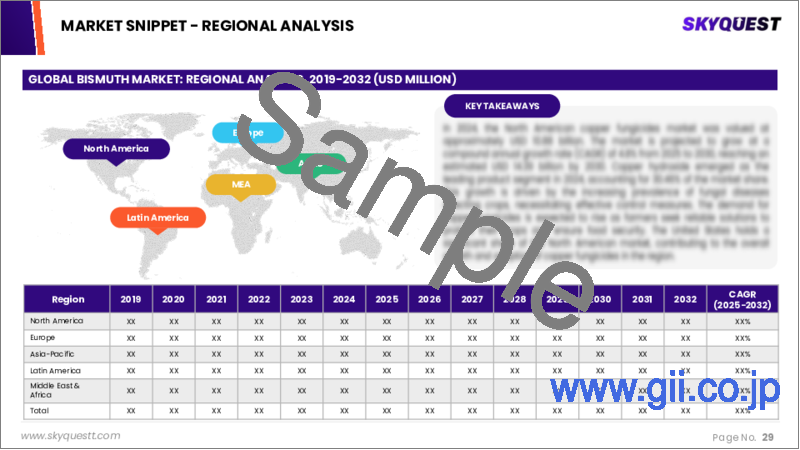|
|
市場調査レポート
商品コード
1649633
ビスマス市場規模、シェア、成長分析:誘導体別、用途別、最終用途産業別、流通チャネル別、地域別 - 産業予測(2025年~2032年)Bismuth Market Size, Share, and Growth Analysis, By Derivative (Oxides, Nitrates), By Application (Pharmaceutical & Cosmetic Additives, Industrial Pigments), By End-use Industry, By Distribution Channel, By Region - Industry Forecast 2025-2032 |
||||||
|
|||||||
| ビスマス市場規模、シェア、成長分析:誘導体別、用途別、最終用途産業別、流通チャネル別、地域別 - 産業予測(2025年~2032年) |
|
出版日: 2025年02月01日
発行: SkyQuest
ページ情報: 英文 157 Pages
納期: 3~5営業日
|
全表示
- 概要
- 目次
ビスマスの世界市場規模は2023年に403億米ドルとなり、予測期間(2025年~2032年)のCAGRは5.0%で、2024年の423億1,000万米ドルから2032年には625億2,000万米ドルに成長する見通しです。
ビスマスの世界市場は、ヘルスケア、電子機器、化粧品など、その用途の広がりによって着実に成長しています。この万能金属は脆く結晶性であることで知られ、制酸作用や下痢止め作用があるため医薬品で重要な役割を果たしています。また、合金、はんだ材料、顔料、熱電材料、特に電子機器の製造に不可欠です。さらに、ヘルスケア分野ではビスマス化合物を胃腸治療、創傷治療、画像処理剤に利用し、化粧品業界では真珠のような性質を持つオキシ塩化ビスマスが好まれています。しかし、市場は限られたビスマス埋蔵量、複雑な抽出プロセス、代替材料との競合などの課題に直面しています。それでも、現在進行中の研究開発と持続可能性への焦点は、将来の市場における革新的なビスマス応用の成長機会を提示しています。
目次
イントロダクション
- 調査の目的
- 調査範囲
- 定義
調査手法
- 情報調達
- 二次データと一次データの方法
- 市場規模予測
- 市場の前提条件と制限
エグゼクティブサマリー
- 世界市場の見通し
- 供給と需要の動向分析
- セグメント別機会分析
市場力学と見通し
- 市場概要
- 市場規模
- 市場力学
- 促進要因と機会
- 抑制要因と課題
- ポーターの分析
主な市場の考察
- 主要成功要因
- 競合の程度
- 主な投資機会
- 市場エコシステム
- 市場の魅力指数(2024年)
- PESTEL分析
- マクロ経済指標
- バリューチェーン分析
- 価格分析
ビスマス市場規模:誘導体別 & CAGR(2025年~2032年)
- 市場概要
- 酸化物
- 硝酸塩
- 金属
- ビスマスサリチル酸
- オキシ塩化ビスマス
- その他
ビスマス市場規模:用途別 & CAGR(2025年~2032年)
- 市場概要
- 医薬品および化粧品添加物
- 工業用顔料
- 冶金添加剤
- 可溶性合金
- その他
ビスマス市場規模:最終用途産業別 & CAGR(2025年~2032年)
- 市場概要
- 製薬
- 化粧品
- 自動車
- 電子機器
- 塗料とコーティング
- 冶金
- その他
ビスマス市場規模:流通チャネル別 & CAGR(2025年~2032年)
- 市場概要
- 直接
- 間接
ビスマス市場規模 & CAGR(2025年~2032年)
- 北米
- 米国
- カナダ
- 欧州
- ドイツ
- スペイン
- フランス
- 英国
- イタリア
- その他欧州
- アジア太平洋
- 中国
- インド
- 日本
- 韓国
- その他アジア太平洋
- ラテンアメリカ
- ブラジル
- その他ラテンアメリカ
- 中東・アフリカ
- GCC諸国
- 南アフリカ
- その他中東・アフリカ
競合情報
- 上位5社の比較
- 主要企業の市場ポジショニング(2024年)
- 主な市場企業が採用した戦略
- 市場の最近の動向
- 企業の市場シェア分析(2024年)
- 主要企業の企業プロファイル
- 会社概要
- 製品ポートフォリオ分析
- セグメント別シェア分析
- 収益の前年比比較(2022年~2024年)
主要企業プロファイル
- 5N Plus Inc.(米国)
- BASF SE(ドイツ)
- Fortune Minerals(カナダ)
- Hunan Shizhuyuan Nonferrous Metals Co., Ltd.(中国)
- Industrias Penoles(メキシコ)
- Merck KGaA(ドイツ)
- Nui Phao Mining Company Limited(ベトナム)
- VIAVI Solutions Inc.(米国)
- Xianyang Yuehua Bismuth Co., Ltd.(中国)
- Hunan Jinwang Bismuth Industrial Co., Ltd.(中国)
- Geotech International B.V.(オランダ)
- TIB Chemicals AG(Switzerland)
- JX Nippon Mining & Metals Corporation(日本)
- Met-Mex Penoles, S.A. de C.V.(メキシコ)
- Umicore N.V.(ベルギー)
- China Minmetals Corporation(中国)
- Changsha Easchem Co., Limited(中国)
- Chenzhou Mining Group Co., Ltd.(中国)
- TTT Metal Powder(中国)
結論と推奨事項
Global Bismuth Market size was valued at USD 40.3 billion in 2023 and is poised to grow from USD 42.31 billion in 2024 to USD 62.52 billion by 2032, growing at a CAGR of 5.0% during the forecast period (2025-2032).
The global bismuth market has been steadily growing, fueled by its rising applications across healthcare, electronics, and cosmetics. This versatile metal, known for its brittle and crystalline nature, plays a crucial role in pharmaceuticals due to its antacid and anti-diarrheal properties. It is also essential in manufacturing alloys, soldering materials, pigments, and thermoelectric materials, particularly in electronics. Additionally, the healthcare sector utilizes bismuth compounds for gastrointestinal treatments, wound care, and imaging agents, while the cosmetics industry favors bismuth oxychloride for its pearl-like qualities. However, the market faces challenges such as limited bismuth reserves, complex extraction processes, and competition from alternative materials. Nevertheless, ongoing R&D and a focus on sustainability present growth opportunities for innovative bismuth applications in future markets.
Top-down and bottom-up approaches were used to estimate and validate the size of the Global Bismuth market and to estimate the size of various other dependent submarkets. The research methodology used to estimate the market size includes the following details: The key players in the market were identified through secondary research, and their market shares in the respective regions were determined through primary and secondary research. This entire procedure includes the study of the annual and financial reports of the top market players and extensive interviews for key insights from industry leaders such as CEOs, VPs, directors, and marketing executives. All percentage shares split, and breakdowns were determined using secondary sources and verified through Primary sources. All possible parameters that affect the markets covered in this research study have been accounted for, viewed in extensive detail, verified through primary research, and analyzed to get the final quantitative and qualitative data.
Global Bismuth Market Segments Analysis
Global Bismuth Market is segmented by Derivative, Application, End-use Industry, Distribution Channel and Region. Based on Derivative, the market is segmented into Oxides, Nitrates, Metals, Bismuth Salicylate, Bismuth Oxychloride and Others. Based on Application, the market is segmented into Pharmaceutical & Cosmetic Additives, Industrial Pigments, Metallurgical Additives, Fusible Alloys and Others. Based on End-use Industry, the market is segmented into Pharmaceutical, Cosmetic, Automotive, Electronics, Paints & Coatings, Metallurgy and Others. Based on Distribution Channel, the market is segmented into Direct and Indirect. Based on region, the market is segmented into North America, Europe, Asia Pacific, Latin America and Middle East & Africa.
Driver of the Global Bismuth Market
The global bismuth market is significantly influenced by the rapid growth of the electronics industry, especially within the realms of renewable energy, automotive, and consumer electronics. As these sectors advance, the need for bismuth surges, primarily due to its application in thermoelectric devices that efficiently convert heat into electricity. This capability not only fosters energy-efficient solutions but also aligns with the increasing emphasis on sustainability and innovation. Consequently, the rising demand for bismuth in various technological applications further propels its market expansion, making it a vital component in the development of modern electronic systems and sustainable energy solutions.
Restraints in the Global Bismuth Market
The global bismuth market faces certain constraints due to environmental and health concerns linked to some bismuth compounds. These compounds can potentially be toxic or hazardous if improperly managed, raising significant safety issues. Therefore, it is essential to implement rigorous handling and disposal protocols to mitigate the risks associated with the use of bismuth. Addressing these concerns is crucial not only for regulatory compliance but also for sustainable market growth, as increasing awareness about safety and environmental impact influences consumer preferences and industry practices. Consequently, the necessity for responsible management of bismuth products remains a critical factor in the market's development.
Market Trends of the Global Bismuth Market
The global bismuth market is witnessing a robust trend towards enhanced utilization in thermoelectric applications, driven by rising demand across key sectors including automotive, renewable energy, and aerospace. Bismuth's superior thermoelectric properties enable efficient conversion of heat to electricity, making it a vital component in energy-saving technologies. As industries increasingly prioritize sustainability and seek solutions to improve energy efficiency while minimizing environmental impact, bismuth-based materials stand out due to their high efficiency, low toxicity, and cost-effectiveness. This trend is expected to accelerate, positioning bismuth as a pivotal material in advancing green technologies and reducing carbon footprints on a global scale.
Table of Contents
Introduction
- Objectives of the Study
- Scope of the Report
- Definitions
Research Methodology
- Information Procurement
- Secondary & Primary Data Methods
- Market Size Estimation
- Market Assumptions & Limitations
Executive Summary
- Global Market Outlook
- Supply & Demand Trend Analysis
- Segmental Opportunity Analysis
Market Dynamics & Outlook
- Market Overview
- Market Size
- Market Dynamics
- Drivers & Opportunities
- Restraints & Challenges
- Porters Analysis
- Competitive rivalry
- Threat of substitute
- Bargaining power of buyers
- Threat of new entrants
- Bargaining power of suppliers
Key Market Insights
- Key Success Factors
- Degree of Competition
- Top Investment Pockets
- Market Ecosystem
- Market Attractiveness Index, 2024
- PESTEL Analysis
- Macro-Economic Indicators
- Value Chain Analysis
- Pricing Analysis
Global Bismuth Market Size by Derivative & CAGR (2025-2032)
- Market Overview
- Oxides
- Nitrates
- Metals
- Bismuth Salicylate
- Bismuth Oxychloride
- Others
Global Bismuth Market Size by Application & CAGR (2025-2032)
- Market Overview
- Pharmaceutical & Cosmetic Additives
- Industrial Pigments
- Metallurgical Additives
- Fusible Alloys
- Others
Global Bismuth Market Size by End-use Industry & CAGR (2025-2032)
- Market Overview
- Pharmaceutical
- Cosmetic
- Automotive
- Electronics
- Paints & Coatings
- Metallurgy
- Others
Global Bismuth Market Size by Distribution Channel & CAGR (2025-2032)
- Market Overview
- Direct
- Indirect
Global Bismuth Market Size & CAGR (2025-2032)
- North America (Derivative, Application, End-use Industry, Distribution Channel)
- US
- Canada
- Europe (Derivative, Application, End-use Industry, Distribution Channel)
- Germany
- Spain
- France
- UK
- Italy
- Rest of Europe
- Asia Pacific (Derivative, Application, End-use Industry, Distribution Channel)
- China
- India
- Japan
- South Korea
- Rest of Asia-Pacific
- Latin America (Derivative, Application, End-use Industry, Distribution Channel)
- Brazil
- Rest of Latin America
- Middle East & Africa (Derivative, Application, End-use Industry, Distribution Channel)
- GCC Countries
- South Africa
- Rest of Middle East & Africa
Competitive Intelligence
- Top 5 Player Comparison
- Market Positioning of Key Players, 2024
- Strategies Adopted by Key Market Players
- Recent Developments in the Market
- Company Market Share Analysis, 2024
- Company Profiles of All Key Players
- Company Details
- Product Portfolio Analysis
- Company's Segmental Share Analysis
- Revenue Y-O-Y Comparison (2022-2024)
Key Company Profiles
- 5N Plus Inc. (US)
- Company Overview
- Business Segment Overview
- Financial Updates
- Key Developments
- BASF SE (Germany)
- Company Overview
- Business Segment Overview
- Financial Updates
- Key Developments
- Fortune Minerals (Canada)
- Company Overview
- Business Segment Overview
- Financial Updates
- Key Developments
- Hunan Shizhuyuan Nonferrous Metals Co., Ltd. (China)
- Company Overview
- Business Segment Overview
- Financial Updates
- Key Developments
- Industrias Penoles (Mexico)
- Company Overview
- Business Segment Overview
- Financial Updates
- Key Developments
- Merck KGaA (Germany)
- Company Overview
- Business Segment Overview
- Financial Updates
- Key Developments
- Nui Phao Mining Company Limited (Vietnam)
- Company Overview
- Business Segment Overview
- Financial Updates
- Key Developments
- VIAVI Solutions Inc. (US)
- Company Overview
- Business Segment Overview
- Financial Updates
- Key Developments
- Xianyang Yuehua Bismuth Co., Ltd. (China)
- Company Overview
- Business Segment Overview
- Financial Updates
- Key Developments
- Hunan Jinwang Bismuth Industrial Co., Ltd. (China)
- Company Overview
- Business Segment Overview
- Financial Updates
- Key Developments
- Geotech International B.V. (Netherlands)
- Company Overview
- Business Segment Overview
- Financial Updates
- Key Developments
- TIB Chemicals AG (Switzerland)
- Company Overview
- Business Segment Overview
- Financial Updates
- Key Developments
- JX Nippon Mining & Metals Corporation (Japan)
- Company Overview
- Business Segment Overview
- Financial Updates
- Key Developments
- Met-Mex Penoles, S.A. de C.V. (Mexico)
- Company Overview
- Business Segment Overview
- Financial Updates
- Key Developments
- Umicore N.V. (Belgium)
- Company Overview
- Business Segment Overview
- Financial Updates
- Key Developments
- China Minmetals Corporation (China)
- Company Overview
- Business Segment Overview
- Financial Updates
- Key Developments
- Changsha Easchem Co., Limited (China)
- Company Overview
- Business Segment Overview
- Financial Updates
- Key Developments
- Chenzhou Mining Group Co., Ltd. (China)
- Company Overview
- Business Segment Overview
- Financial Updates
- Key Developments
- TTT Metal Powder (China)
- Company Overview
- Business Segment Overview
- Financial Updates
- Key Developments






